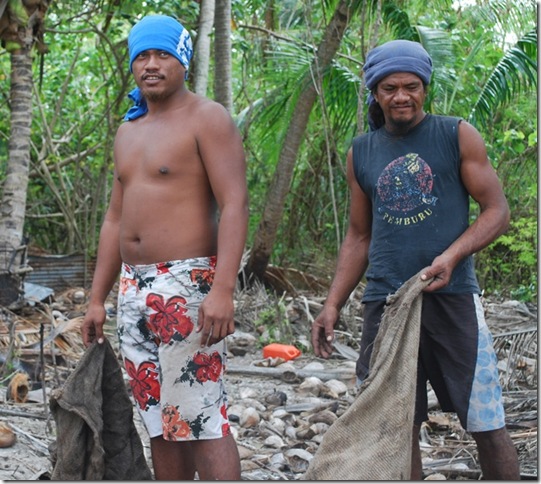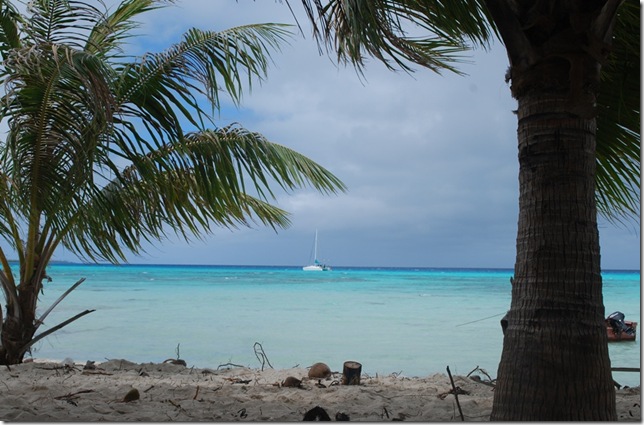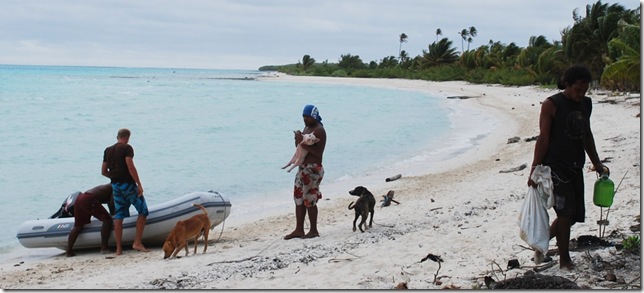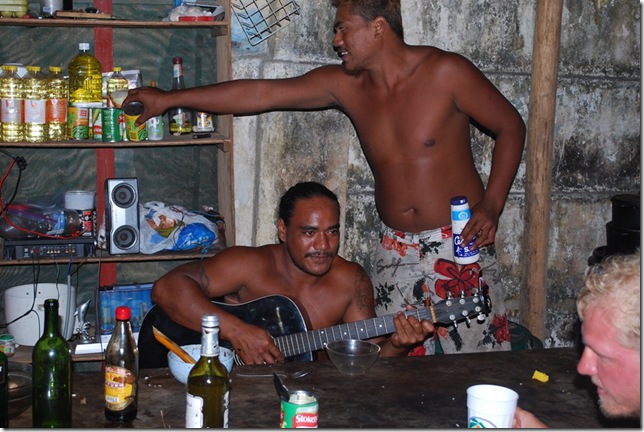Lat: 16 58.034′ S
Lon: 154 30.101′ W
We were awakened yesterday by shouts of “Hello, Bonjour!” I scrambled out to the cockpit and found the guys from the atoll approaching in their boat. They brought four lobsters and three small parrotfish for the second pack of cigarettes. They also asked about some cookies for the kids, but Lauren and I wanted to go ashore anyway, so we told them we’d be in later with some more things.
During breakfast, we downloaded a GRIB file and saw that things would be more pleasant for us offshore if we waited another day to leave, which was just fine with everyone after getting tossed around a bit on the way over.
Mopelia is obviously quite isolated and the mode of life simple, so we tried to pack a decent bag of stuff for them — a couple of shirts, a good pair of work gloves, candles, tea, candy and ribbons for the kids, canned corned beef, WD-40, and some fresh cookies Lauren had made. It’s really nice to be able to give things to people in places like this. When we got ashore, we found a couple of them working on copra by prying the meat from the coconuts. We made introductions and found that this part of the island was inhabited by Kalami (22), his wife Sophie, their two boys (one year and one month, respectively), Kalami’s male relatives Bako (33) and Ruta (25), and an 11-year old son of a friend. They offered us some “locale/Tahitian biere” (did I mention it was 10 a.m.?), which is a concoction they make from rain water, sugar, and yeast. It was very drinkable (tastes like a strong, slightly sweet white wine) and we sat down on a couple of burlap copra sacks to chat. The guys in their 20’s looked about as old as Lauren and I, and at 33, Bako would have passed for a grizzled 48 back in the states, but they were friendly and laid-back.
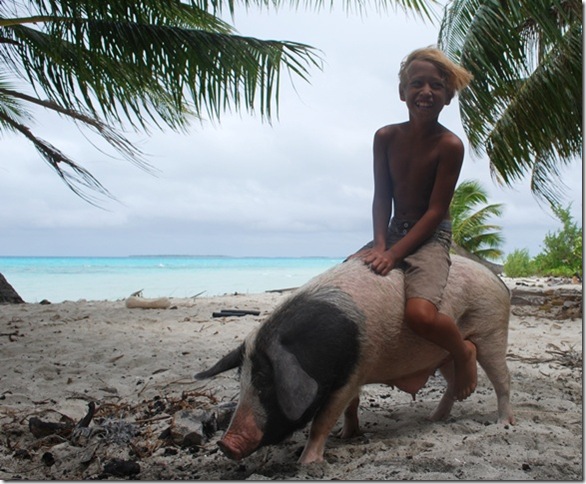 Yes, a pig does move along rather quickly when you reach back and slap it on the behind
Yes, a pig does move along rather quickly when you reach back and slap it on the behind
We were talking on the beach, looking out over the lagoon and at Pura Vida at anchor when it started to sprinkle and we all headed to the house. The house is sort of what you see on television when Sally Struthers is trying to get you to send money to save starving kids. Part of the building was old concrete, but the roof and places that had an outer wall were corrugated tin. There was only one partial inner wall made from a variety of materials that separated the area where Kalami and Sophie sleep. Interestingly enough, they have a couple of solar panels, a deep-cycle battery, and a couple of portable DVD players that also play music as well as an old amp and one above-dash automobile speaker. They were interested in having us burn some CDs for them (UB40, Bob Marley, Bon Jovi, etc.) and before too long they decided we should have a party that night.
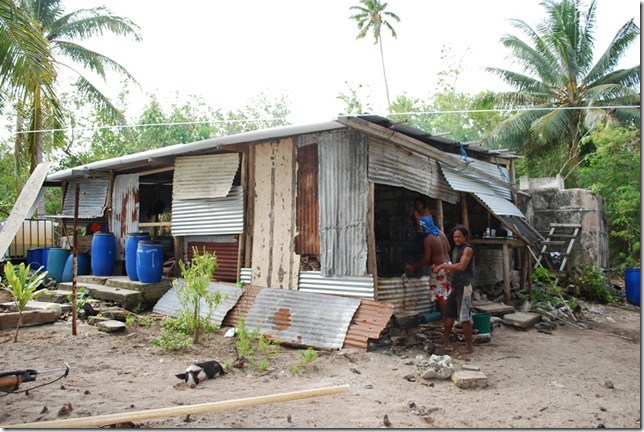 The casa (one of three on Mopelia)
The casa (one of three on Mopelia)
There was another boat anchored out on the reef, and the plan was to invite them to the party as well. The first step was go see Kalami’s Dad to pick up a small pig and some local beer for the party. Ruta and I drew pig and beer-fetching duty, and we headed out. I learned on the way that this meant a boat trip to the far south of the island. As they don’t have much fuel, we were to go in our dinghy. That was no problem, but the dinghy engine has slowly been losing power, and it wasn’t doing well at all. It turns out Kalami’s dad lives at the other end of the atoll, about 4 miles away, and we couldn’t get much above idle power. For some reason, you can rev the motor up, and the prop spins, but there’s no thrust. That’s not covered in the service manual’s two pages on troubleshooting, so it’s going to be a project. Anyway, we eventually decided to turn around and swap boats as we were getting nowhere, and I didn’t want to get stranded.
On the second attempt, we put Kalami’s engine on our dinghy, and we eventually made it. The boat that was anchored out on the reef turned out to be one of the boats we met in Bora Bora, and they were now anchored in the beautiful, peaceful area at the south of the atoll. Ashore, Ruta said hello to Kalami’s parents and set to work. Their place is almost too much to put into words, but imagine a stereotypical rural Appalachian or Arkansas one-room shack, all sorts of modern and primitive items strewn about the yard, a couple of large copra-drying racks, and numerous pigs, dogs, and ducks (first time to see them here). Now superimpose that on a beach and lagoon that Club Med would be drooling over if it wasn’t on an atoll in the middle nowhere. Kalami’s Dad was a chubby, amiable fellow with a big head of curly hair who wore a T-shirt and pair of briefs/speedos, which passes for casual wear on the atolls and takes a bit of getting used to. First, we grabbed a couple of pigs and tied them by the leg to a hammock near the beach. One was larger than the other, but both were small and white. We also grabbed a sort of grill to cook the pigs and Ruta filled the bottles we brought with the local beer. Kalami’s Dad makes the stuff in a big water barrel and also had some bananas in this batch. In typical island style, the bottles are any glass bottle or jug that’s been left or found, especially wine bottles. For corks, there’s a type of foam fishing buoy hanging from the re-bar protruding from the roof that can be cut and stuffed into the neck of the bottle.
We loaded the pigs, grill, and a pretty fair amount of the “locale biere” into the dinghy and finally arrived back several hours after we’d originally left. I’d inadvertently left Lauren there for several hours, but she managed well, getting to know the family. They receive a visit from about three trading boats a month from nearby Maupiti. They keep a number of pigs and there are also wild pigs on the island, so they trade pigs for cigarettes, baby food, and other commercial goods. They also get about 3 cruising boats a week during the season (an additional item we picked up at at Kalami’s father’s place was a guestbook filled with entries from visiting yachts). There’s essentially no money on the island, and they prefer the subsistence and trading existence to the monetary and labor economy. They have plenty of fish and meat, and grow a few vegetables as well. Lauren also learned how to make coconut milk, which has been something we’ve wanted to figure out. The key is to get a young coconut and the proper tool. They use a device that looks like a paddle with a scraper at the end of the handle. You sit on the fat part and use the scraper between your legs to clean the soft meat from a young coconut. The meat can then be wrung out using a cheesecloth to produce the milk that’s used for dishes like poisson cru.
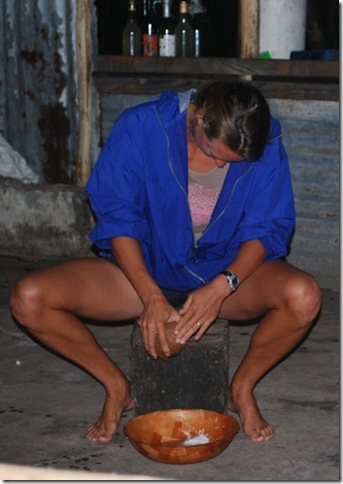 Lauren grating the meat out of a young coconut
Lauren grating the meat out of a young coconut
Dinner that night consisted of barbecued ribs, poisson cru, rice, and a second pork dish (I’m not sure which pig was ribs and which was stew, but Lauren says they were both good as long as someone else is doing the presto-change-o). For me, they even broke out a can of corn. Before we could get started eating, though, we had to make a quick run back to the boat for place settings for Lauren and I. As they were drinking from old wine bottles and bowls it doesn’t appear they have cups, and they didn’t have any extra plates or forks. No worries, as we’d forgotten my guitar as well.
After dinner the singing started. It turns out Ruta is an incredibly good guitar player even though he doesn’t own one and hasn’t touched one for 5 months. In addition to Tahitian and French songs, he played Bob Marley, Metallica, improvisations, and did some pretty impressive picking. Everybody joined in, and Ruta even got me to attempt some improvised vocals, which isn’t something you’ll be hearing anytime soon. There were songs about everything from my love / mon cherie to Jacque Chirac, to the moon and the pass, but Lauren and I almost died laughing when they all of a sudden started singing the French version of Hakuna Matata from the Lion King. Ruta was pretty impressed with the guitar and offered all the lobster in Mopelia for it. Unfortunately, I’m a vegetarian and we don’t have a freezer now, so we all had a good laugh at that being unfortunate for him. Because of the issues with our motor, Kalami and Bako took us back using their boat at the end of the night. The route is littered with shallow water and large coral heads, so we used a large light we had and left it with them to get back safely.
This morning, Kalami returned with the light and guestbook for us to sign (they hadn’t had a pen at the house the night before) and I gave him a few more things, including a low-power, guaranteed-for-life LED light that should help out a bit in the home lighting department. It seemed like we were both sad to say goodbye, but such is our life. The sun had come out and the wind had lightened up a bit, making our weather planning seem worthwhile. Tiff cooked up the lobsters and we enjoyed lunch before pulling up the anchor and motoring across the lagoon.
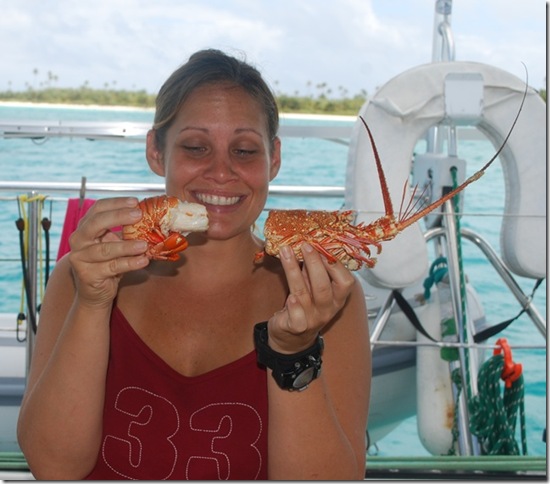 Et Voila! 1/4 of a pack of cigarettes worth of lobster
Et Voila! 1/4 of a pack of cigarettes worth of lobster
This place is so beautiful that we all just sat on deck and watched silently as we made our way toward the pass. Before we knew it, we were through the pass and out into open water. Tiff pulled down the French courtesy flag, and our visit in French Polynesia officially came to an end. It was a wonderful last stop and one that we’ll remember for a long time. Lauren looked through the guestbook and noticed that several boats had returned to Mopelia a second time after several years, and there’s no doubt we’d do the same if we came this way again.
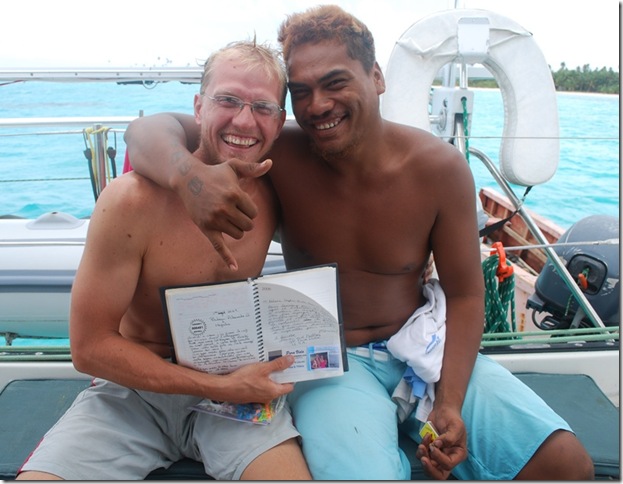 Our page in the Mopelia guestbook
Our page in the Mopelia guestbook
The seas are still up a bit, but not as bad as they were, and the sun is out, making it a beautiful day for sailing. We’re using just the jib again and are averaging above 5 knots with no problems.


